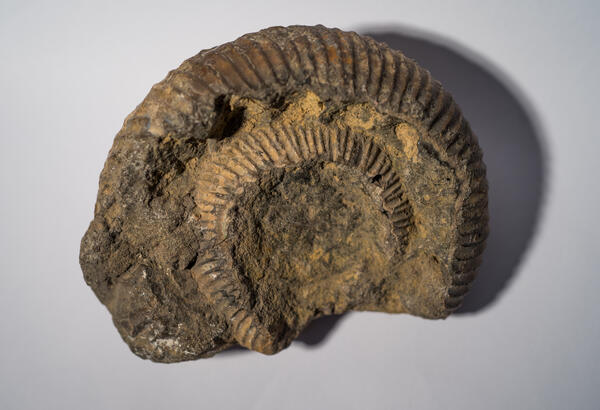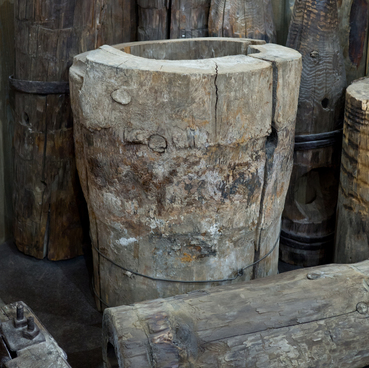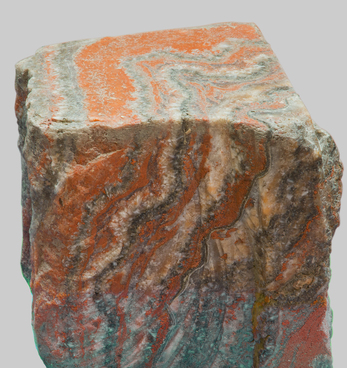Over 250 million years ago, during the Permian period of the Paleozoic era, the Perm Sea stretched from the Arctic Ocean to the modern Caspian Sea. Algae, corals and polyps formed coral reefs that attract marine invertebrates - brachiopods and bivalve molluscs; the bottom of the sea was inhabited by trilobites, gastropods, sea urchins, and numerous fishes and ammonoids were found in the water column.
Ammonoideas or Ammonites are a subclass of extinct cephalopods. They existed from the beginning of the Devonian to the end of the Cretaceous - 395–65 million years ago. The Ammonites got their name in honor of the ancient Egyptian god Amun Ra, who was depicted as a man with the head of a ram with twisted horns. The clamshell also resembles a horn twisted with the ending inward.
The shell of the Ammonites is divided by partitions - septs - into many isolated chambers. The chambers of the shell are connected by a thin solid tube - a siphon. In the last, largest chamber, the body of a mollusk was placed, others were filled with air. Thus, the shell served as a float, thanks to which the Ammonites could drift.
According to the structure of shells, Ammonites are divided into evolute and involute ones. In evolute ammonoids, the shells are coiled in such a way that all their internal whorls are not closed by the latter, but remain visible. In involute shells, each whorl is closed by the next one.
The history of the study of the Ammonite family in the Urals began over 150 years ago. In the 19th century, scientists described and established the first species of Permian ammonoids. Due to their intense evolution and rapid dispersal, Ammonites are important guide fossils - that is, fossils that are characteristic of a particular geological period and do not occur either later or earlier. This group is especially important for delineating the deposits of the Jurassic and Cretaceous systems.
In the Permian period, powerful mountain-building and volcanic activity was manifested. Tectonic movement caused the emergence and disappearance of the seas. Gradually the Perm Sea left, and the Ural Mountains began to grow in its place. Most Ammonites have been found in sedimentary rocks.
At that time, a thick salt formation occurred, which became the basis for deposits of potash salts - the main wealth of the Upper Kama region. In 1430, the town of SolikAmsk was founded on the Kama River, where they were engaged in salt production. Until now, the potash industry is the basis of the economic life of SolikAmsk and neighboring BereznikI.
Ammonoideas or Ammonites are a subclass of extinct cephalopods. They existed from the beginning of the Devonian to the end of the Cretaceous - 395–65 million years ago. The Ammonites got their name in honor of the ancient Egyptian god Amun Ra, who was depicted as a man with the head of a ram with twisted horns. The clamshell also resembles a horn twisted with the ending inward.
The shell of the Ammonites is divided by partitions - septs - into many isolated chambers. The chambers of the shell are connected by a thin solid tube - a siphon. In the last, largest chamber, the body of a mollusk was placed, others were filled with air. Thus, the shell served as a float, thanks to which the Ammonites could drift.
According to the structure of shells, Ammonites are divided into evolute and involute ones. In evolute ammonoids, the shells are coiled in such a way that all their internal whorls are not closed by the latter, but remain visible. In involute shells, each whorl is closed by the next one.
The history of the study of the Ammonite family in the Urals began over 150 years ago. In the 19th century, scientists described and established the first species of Permian ammonoids. Due to their intense evolution and rapid dispersal, Ammonites are important guide fossils - that is, fossils that are characteristic of a particular geological period and do not occur either later or earlier. This group is especially important for delineating the deposits of the Jurassic and Cretaceous systems.
In the Permian period, powerful mountain-building and volcanic activity was manifested. Tectonic movement caused the emergence and disappearance of the seas. Gradually the Perm Sea left, and the Ural Mountains began to grow in its place. Most Ammonites have been found in sedimentary rocks.
At that time, a thick salt formation occurred, which became the basis for deposits of potash salts - the main wealth of the Upper Kama region. In 1430, the town of SolikAmsk was founded on the Kama River, where they were engaged in salt production. Until now, the potash industry is the basis of the economic life of SolikAmsk and neighboring BereznikI.



